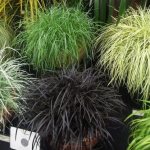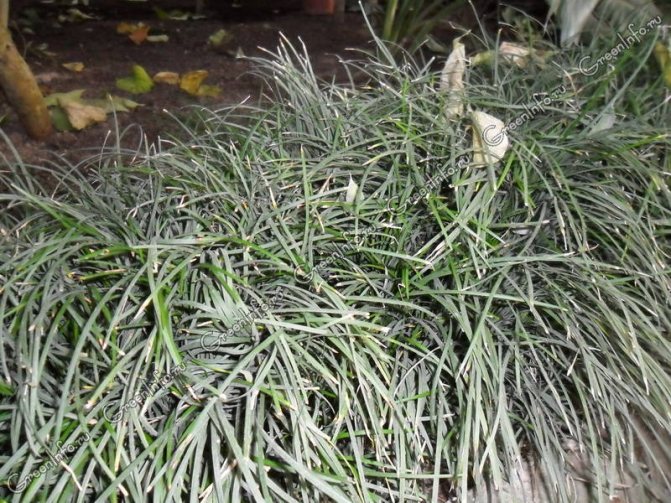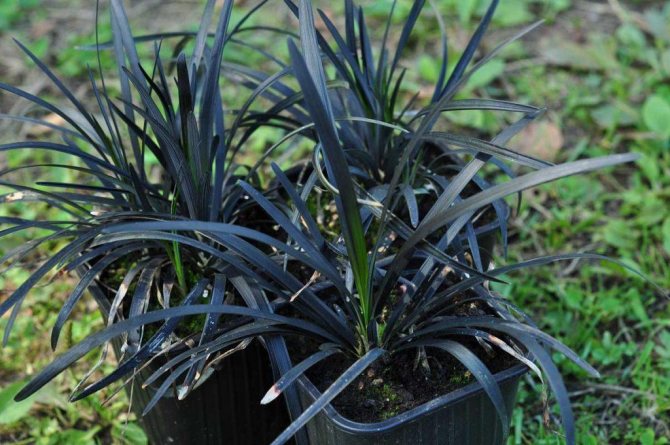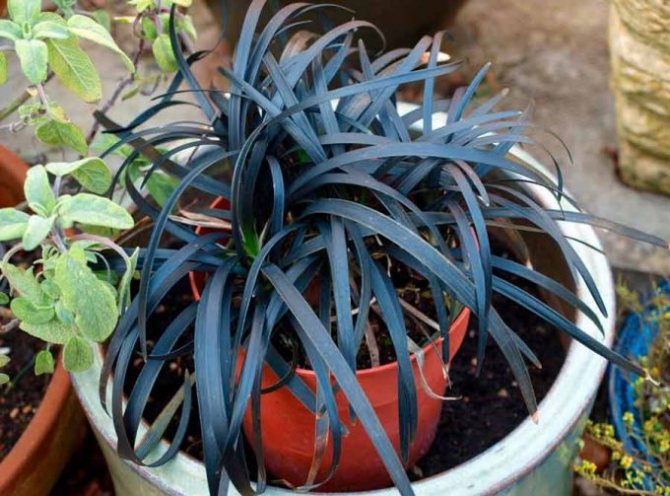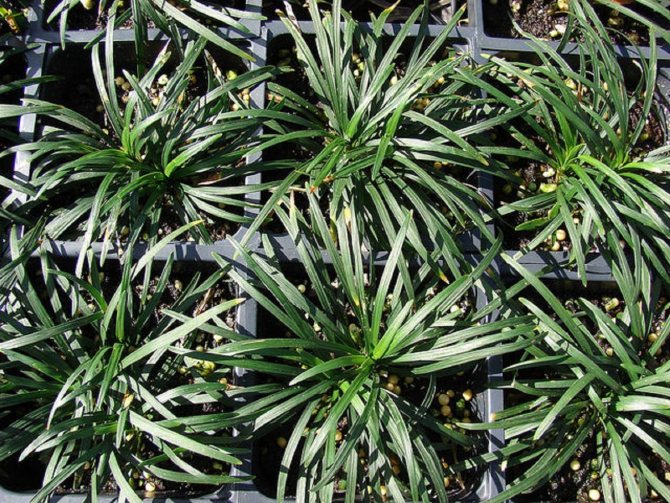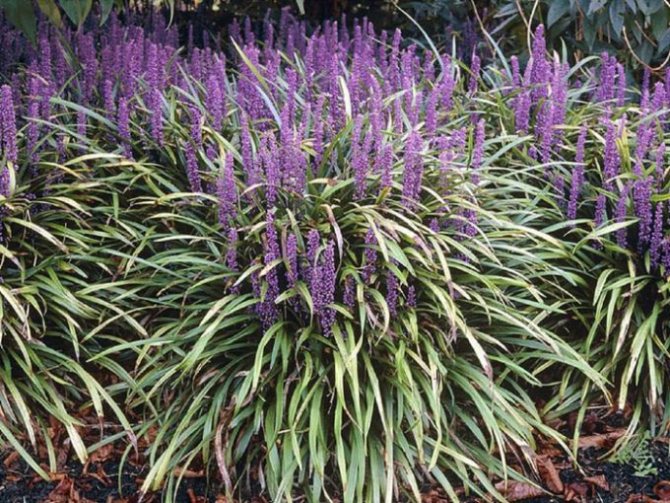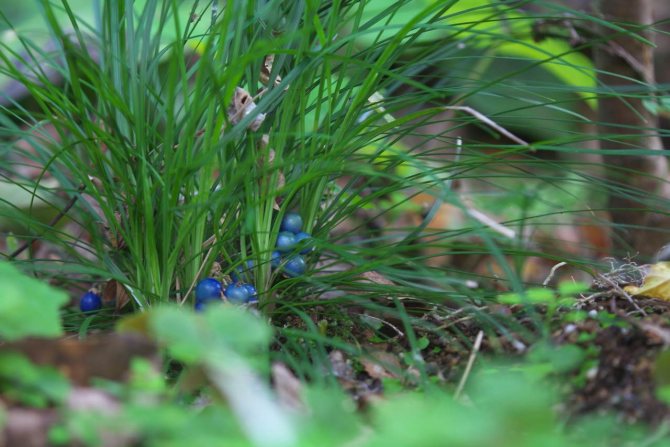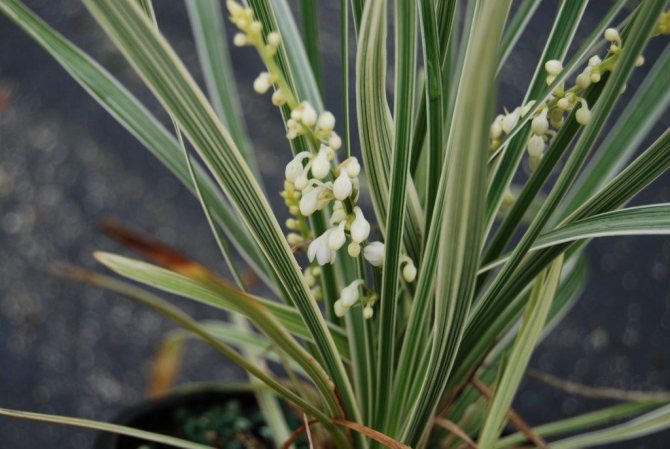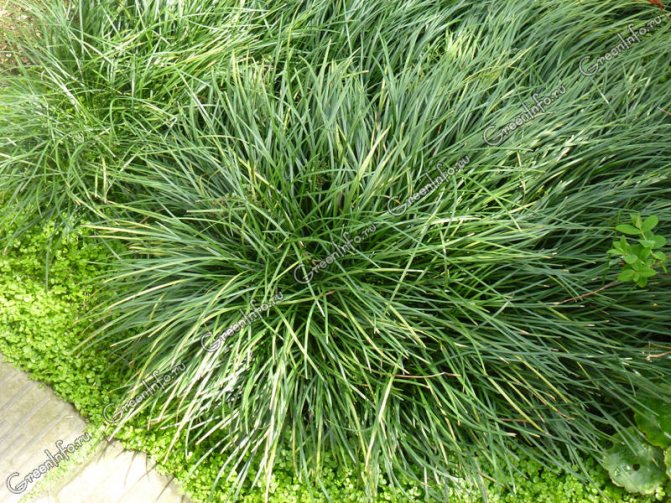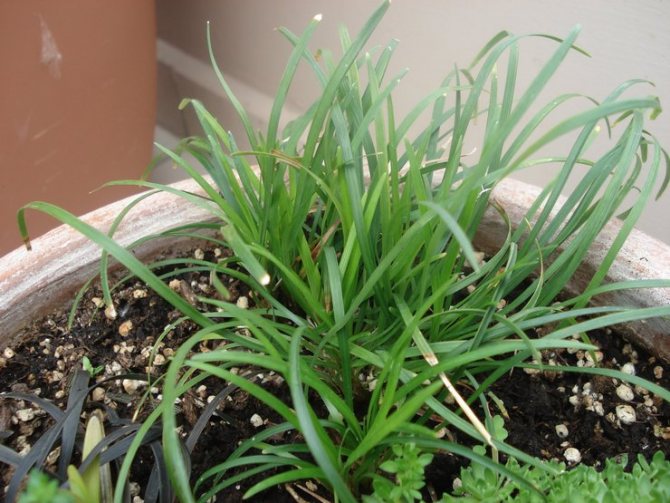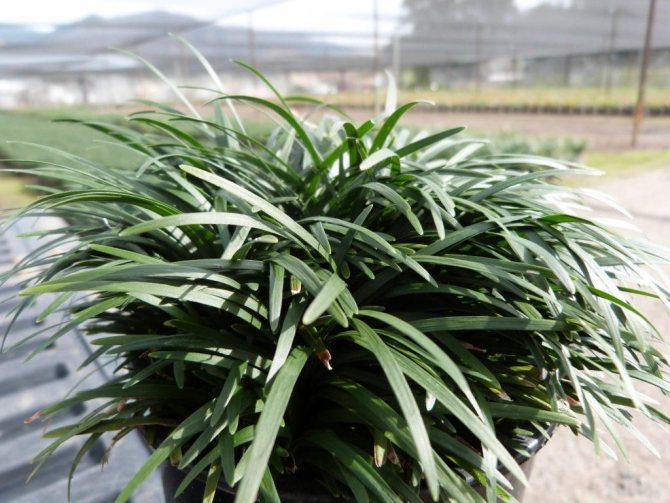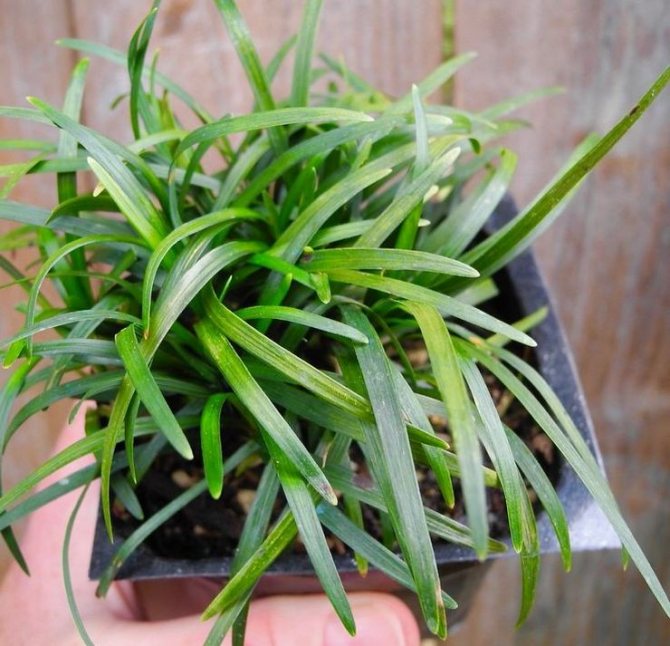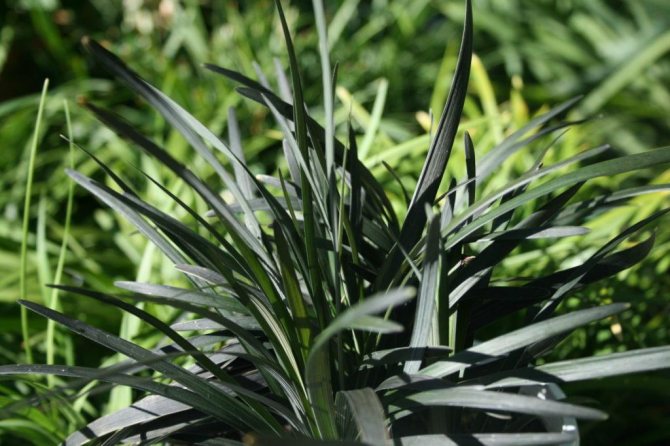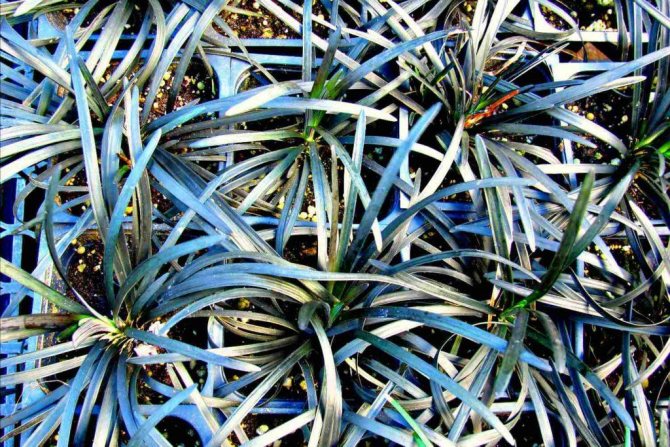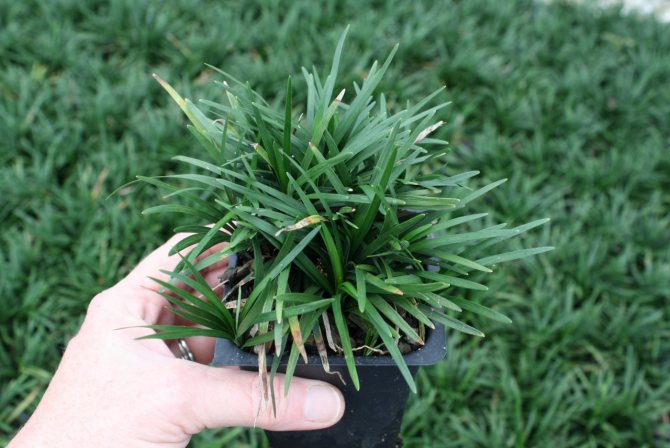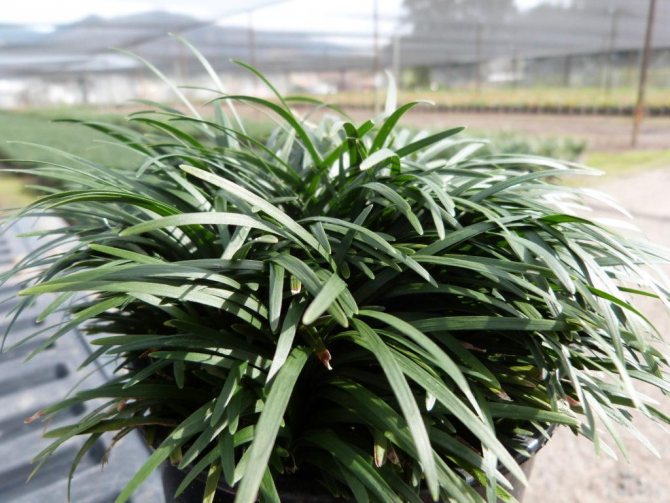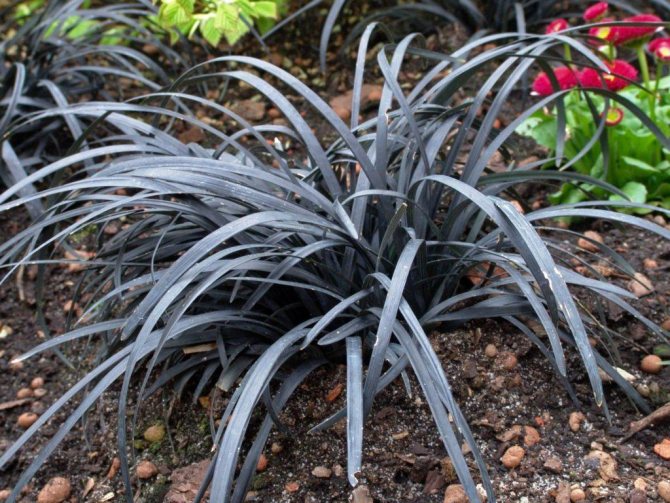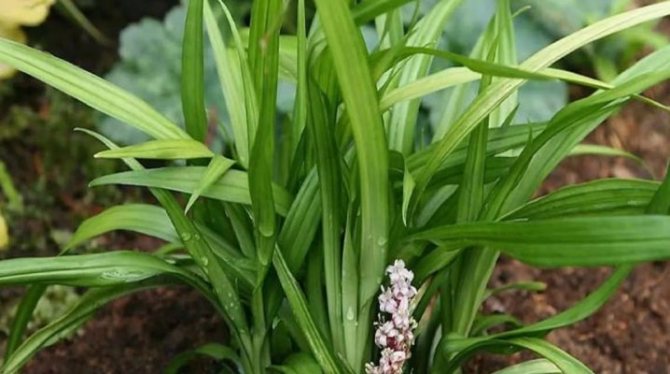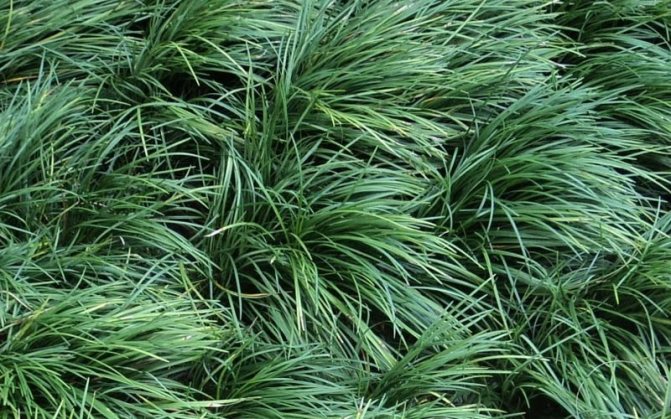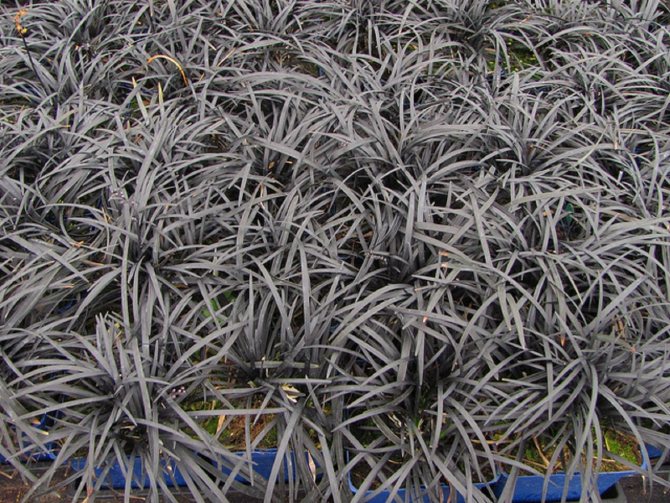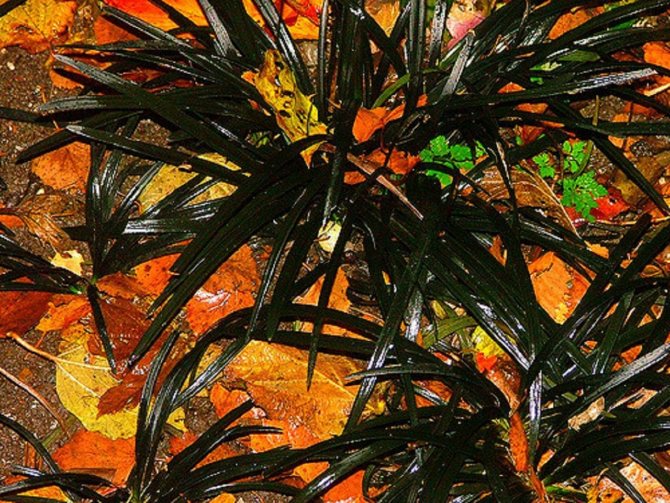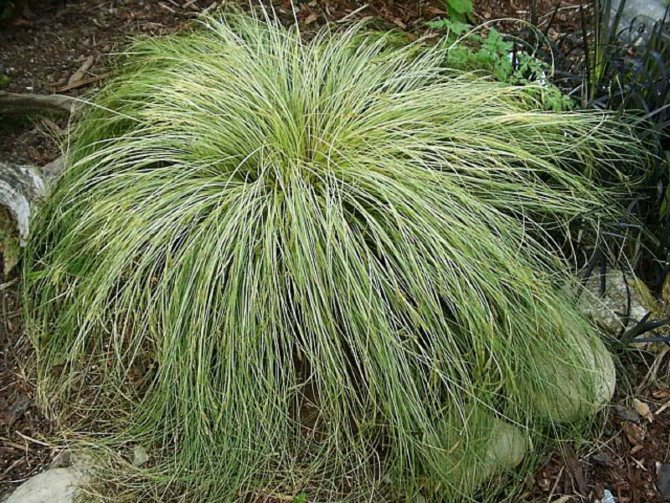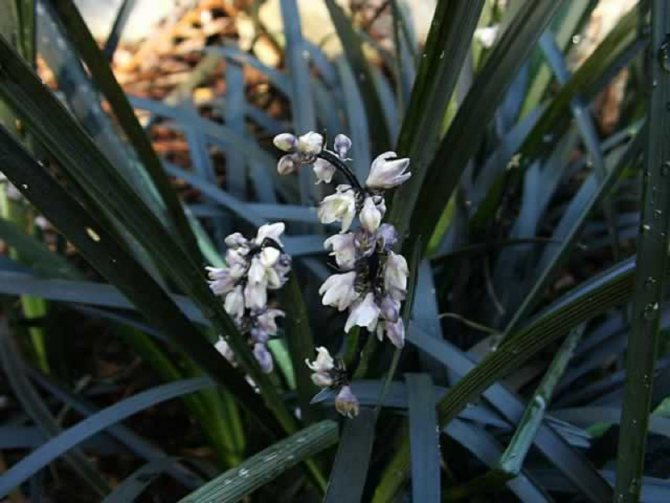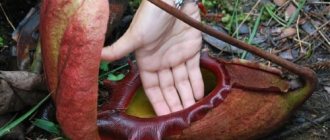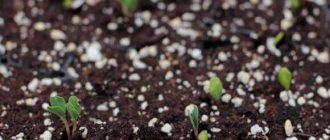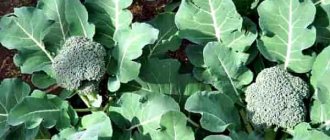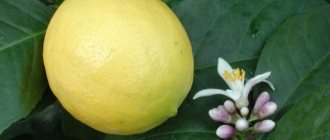Ophiopogon is a perennial herbaceous evergreen plant native to Southeast and South Asia, where it grows in the shade of shady forests. Despite the fact that the appearance of representatives of the genus is indistinguishable from grass or cereals, the culture belongs to the Liliaceae family.
Growing, the plant forms lush and dense clumps of numerous narrow leaves collected in a rosette. The root system is shallow, with small tubers on the roots.
The culture is decorative from spring to late autumn and not only due to the magnificent varietal forms of oriental grass. For delicate white, lilac and violet-white bell flowers, collected in spike-shaped inflorescences, the plant is often called "Japanese lily of the valley". Flowering begins in July and lasts until early autumn.
Planting and caring for ophiopogon in the open field is not difficult, so the Japanese lily of the valley has recently been very popular with gardeners.
Plant classification
Ophiopogon is small, tough leaves and belongs to the category of evergreens. One of the features of which is the mandatory presence of as much sunlight as possible.
It grows very slowly. As the clumps of leaves grow larger, the plant can be split into several separate shrubs.
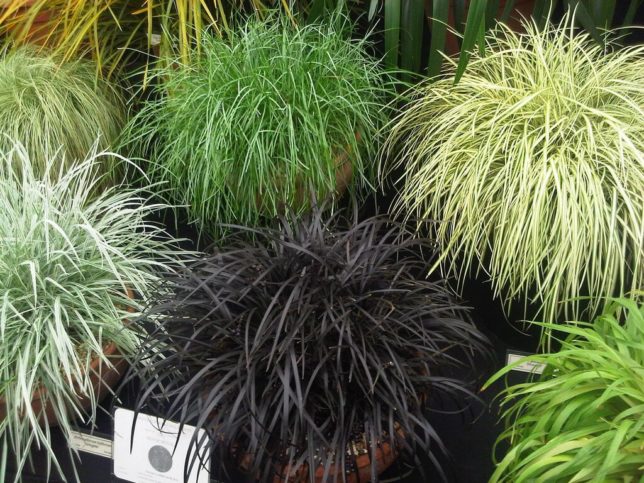
Types of Ophiopogon:
- Ophiopogon intermedius.
Flowering and fruiting: small white flowers in suspension form, formed in June-July, then fruits ripen in the form of round berries, which are dominated by bright or bright blue tones.
Vegetation: Height: 0.10 -0.15 m. Dense and branched bunch, narrow leaves, shiny, strongly pronounced dark green color.
Qualities: Ideal for growing in pots or containers.
- Lily of the Valley (Ophiopogon japonicus).
Flowering and fruiting: In early summer, small flowers appear on the stems, resembling pale white lilacs in color, at the end of summer from which fruits are formed in the form of blue pea-sized berries.
Vegetation: Height: 0.20 m. A dense bunch of shiny dark green hard leaves with a long and thin shape.
Qualities: Excellent for growing on the ground in the garden or on the lawn.
- "Minor".
Flowering and fruiting: creamy flowers followed by turquoise blue fruits of the same size as the species.
Vegetation: height from 0.07 to 0.10 m. Dwarf form with more compact size.
Qualities: Very long-lived plant, used as a grass substitute without mowing.
- "Silver Mist".
Vegetation: Height: 0.20 to 0.30 m. Narrow green foliage with a creamy central stripe.
- Black Ophiopogon (Ophiopogon planiscapus 'Nigrescens').
Flowering and fruiting: small flowers in a pinkish-white bell in July, followed by bluish black ovoid berries.
Vegetation: Height: 0.20 m. Narrow foliage, linear, black.
Qualities: Slow vegetation. Suitable for stony, hard soils.
Ophiopogon planiscapus Nigrescens
The plant received the Award of Garden Merit (AGM) from the Royal Horticultural Society of Great Britain in 1993.
Synonyms:
Niger (Niger), Arabicus (Arabicus), Black Dragon (Black Dragon, Black Dragon), Lily of the valley.
Plant group:
cereal perennial.
Family
:
lily.
Habit:
hummocky.
The form:
unique and inimitable in terms of decorativeness, an unusual perennial evergreen ornamental cereal, 20-50 cm high with spectacular, almost black, arched leaves and light bell-shaped flowers. Ophiopogon flat-shot Nigrescens is distinguished by abundant fruiting.
Leaves:
basal, thin, linear, collected in bunches, almost black with a metallic shade, which together form a dense turf. Leaves persist year-round and die off almost imperceptibly.
Bloom
:
drooping, small, bell-shaped, white-pink flowers in bunches of 3-8 pieces are collected in spike-shaped brushes. They stand out favorably against the background of dark foliage.
Flowering time:
July August.
Fruit:
numerous fleshy blue-black berries.
Root system:
short thickened rhizome with intertwined fibrous roots and root cones.
Attitude to light
/insolation:
grows well in full sun and partial shade. It blooms more abundantly in light shade.
Humidity:
Ophiopogon Black Dragon prefers moderate humidity at the place of growth, does not tolerate boggy.
Soil type
/soil:
loves moist, light, loose, humus and nutrient-rich soils, with a slightly acidic soil reaction.
Planting / leaving:
The main manipulations for the care of Ophiopogon Nigrescens are weeding, watering, removing, dry or damaged parts. Planting time of perennials in containers grown in the nursery lasts the entire growing season. Spring is considered the best time, although planting in August, September and even October also gives good results. Perennials planted in the late autumn period must be protected from freezing before winter.
All plants purchased from the PROXIMA nursery are provided with prolonged fertilizers with the latest formulas of the best European manufacturers and can be sold in your garden center without additional fertilizing for a whole year. But the biggest advantage of buying potted plants is that they can be planted, without buying additional fertilizers, from March to December - even on the hottest days of summer.
Pests / Diseases:
Ophiopogon Arabicus is extremely rarely affected by diseases and pests. But from the possible threats, rhizome rot and leaf spot can be distinguished. And also snails are partial to young leaves.
Application:
only recently have perennials been interpreted as an even-row element of a garden composition. They are suitable for gardens and parks, the source of the creation of which was the tradition in the English style, and the art of the East, the harmony of China and Japan. All of them are based on the fact that the basis of the garden is the natural beauty of plants, subject to continuous changes in time and space.
Ophiopogon planiscapus Nigrescens is used in both single and group plantings. Unusually beautiful ophiopogon inflorescences are used to create dry floristic compositions. In order to “compensate” for the absolute absence of cereal grasses in the overwhelming majority of Ukrainian gardens, garden centers and landscape designers faced the task of popularizing perennial cereals. Wet lawns, sometimes with one mowing, high solitary plantings in sunny places, roof gardens, framing a natural and artificial reservoir, a bed in the sun (plants found on open wild surfaces of meadows, steppes), in the first rows of a flower garden, among low conifers, in mixborders, rockeries, rock gardens, composition of herbs in wet partial shade, etc.
Ophiopogon flat-shot Black Dragon looks very elegant in contrasting compositions, against the background of plants with light foliage or, for example, on white decorative pebbles.It looks no less impressive in various rocky gardens, low curbs and mixborders, as well as in containers.
Climatic zone / frost resistance zone: 5-
6
frost-resistant for the entire territory of Ukraine. To protect against burns, cover with shade or white non-woven synthetic material. With the help of elementary care (watering, weeding the near-trunk circle, mulching, fertilization, shelter), you can protect the plant throughout Ukraine.
You can buy Ophiopogon flat-shot Nigrescens in Kiev at low prices in the PROXIMA plant nursery.
You can use a variety of plants to decorate your backyard area. In the garden, you can grow large flowers and lawn grasses, you can arrange a flower bed of many different plants that bloom at the same time, or one after the other. In general, every gardener will find among the whole variety of flora exactly those crops that suit his garden. And one of the amazing ornamental plants is the Japanese Ophiopogon Silver Mist, we will clarify for the readers of Popular About Health how planting is carried out, and what kind of care is needed for this culture in the open field.
The Japanese ophiopogon is also known as the Japanese lily of the valley. This plant came to us from Japan and China. There are several varieties of this culture, and one of them is Silver Mist. Ophiopogon Silver Mist is a perennial, it has thin and rather rigid leaves, the length of which can reach thirty-five centimeters. A distinctive feature of the Silver Mist variety is the dark green leaves on which white stripes are located. Such a plant is capable of producing pale purple flowers. Flowering continues throughout the summer - until September. After that, blue berries are formed on the plant.
All varieties of Japanese ophiopogon, and mist silver among them, grow well and take root only in mild climates. Therefore, such a plant will be an ideal option for those who live near the Black Sea coast.
Ophiopogon - planting and care in the open field
Planting Japanese ophiopogon in the open field
To grow Japanese ophiopogon in the open field, you must first get the seedlings of this plant. And for this purpose it is necessary to collect seeds. Fully ripe berries without a green tint are suitable for you, they are usually visible on the plant towards the end of October or early November. However, remember that fully ripe seeds may well become desirable prey for birds.
To get seeds from ripe berries, simply crush them with a teaspoon. Rinse the resulting planting material and soak in clean, settled water for several days. Be sure to change the water to new water every day.
After pecking, the seeds must be planted in modular boxes at intervals of two and a half to three centimeters. In this case, there is no need to somehow sterilize the soil or use antifungal agents. It's just that the compost must be of high quality and fresh. After spreading the seeds over the surface of the soil, cover them with a thin layer of compost and water gently. After that, cover the box with a plastic lid or a layer of polyethylene, and send it to a rather cool place - with a temperature of about ten degrees. Monitor the moisture content of the soil carefully - do not let it dry out. After the emergence of shoots, you need to remove the shelter from the box.
When sowing seeds in late November, the seedlings will be large enough to plant by around May. In this case, the percentage of germination often reaches one hundred percent, however, not all plants are viable.
Landing in open ground
Outdoors, Ophiopogon Silver Mist can begin to grow when the seedlings reach a height of about ten centimeters.Experienced gardeners advise placing this plant in shady corners of the garden, but not in full shade. If ophiopogon is in direct sunlight, it will not bloom and may lose its decorative effect.
Such a plant is not very demanding on the soil. It feels great on wet, slightly acidic soils. The land must be fertile and humic. In addition, good drainage plays an extremely important role - Japanese ophiopogon does not tolerate moisture stagnation.
Young plants are best planted in the garden at intervals of fifteen centimeters. After that, it will not be superfluous to form a medium-sized hill of humus or cover the planting site with plucked grass - so young sprouts will be protected from a possible cold snap.
Why is ophiopogon demanding, what should be included in caring for it
? In fact, such a plant is not very demanding on growing conditions. It tolerates drought well, but grows well if it receives a regular supply of moisture. Caring for ophiopogon, perhaps, consists only in feeding. So it will not be superfluous to feed young plants using a complete mineral fertilizer. And in the future, flower growers recommend feeding Japanese ophiopogon with leaf humus every autumn.
During the cold season, the Japanese ophiopogon needs some shelter. It is quite possible to create a protective layer for rhizomes from mulch with a thickness of two to five centimeters. Peat or sawdust can be used as a mulching material. A layer of dry leaves should be placed on top. And on top ofiopogon it is advised to cover it with spruce branches.
Additional Information
Silver mist is great for forming landscape compositions. It is advised to combine it with stones and mosses, and it also looks great in the company of ferns and woody plants.
Most often, this culture is planted to form curbs and as a ground cover plant. Ophiopogon leaves are capable of forming rather dense rosettes: many offspring appear from the rhizome, which over time form a mat that completely covers the soil.
Thus, outdoor ophiopogon will be an excellent design find for residents of warm regions. An unpretentious plant can decorate any garden.
Decorative leaves and cute flowers of Japanese ophiopogon, combined with the unpretentiousness of this plant, make it a welcome guest of houses and.
In literature, the name of this flower is often translated as "Japanese lily of the valley". This comparison was due to the similarity of flowers. Just like the lily of the valley, they are located on a thin peduncle that appears in the center of the plant among the flat ones. The brushes consist of several dozen small flowers. Each elongated tube has a miniature lily.
The leaves of Japanese ophiopogon are flat, not more than five centimeters wide, pointed at the end.
Initially, in their homeland in Japan, they were dark green in color. But now varieties with heterogeneous leaf color have been bred:
- A narrow white stripe along the entire sheet cuts it lengthwise.
- A wide strip of white or cream shade occupies almost the entire leaf, and only along the edge is it green.
This guest from Japan is similar to an ordinary lily of the valley in the way of breeding. Its roots also grow over great distances.
In natural natural conditions of growth, this plant is.
Ophiopogon can be grown outdoors as a perennial only in areas with mild winters. He does not tolerate frost.
In areas with harsher winters, the plant can be grown as an annual, but in this case it does not grow in large clumps.
Most often in such cases it is grown as.
Regardless of the climate and place of residence, the Japanese ophiopogon will liven up a corner of the house or garden. You just need to find an appropriate place for it.
Planting Ophiopogon
Ophiopogon grows on regular soil, fresh but well-drained, fertile and fairly weakly acidic soil. It supports clay soils as long as they are not damp in winter and grow faster in humus-rich soil. The plant is afraid of calcareous soils.
It is a semi-reflective plant, but is suitable for almost all exposures as long as the soil remains cool, especially if it is planted in the sun. Does the plant support summer drought after proper planting?
Having tolerated down to -15 ° C, it is necessary to cultivate it in a pot in those regions where the temperature is outside the limits. Be careful, in the jar it is more sensitive to frost.
Indoors, he prefers a cool atmosphere and bright light, but not full sun. The ideal temperature is 13 to 18 ° C, and a window facing east or west suits it very well. In a less light situation, it may not bloom.
Planting time is in autumn or early spring (March or April).
- In the ground:
Place the plant in well-cleaned soil and enrich with compost. Plant the legs 20 to 60 cm deep, depending on the size of the adult plant and the length of the leaves.
- In pots:
Use a rich earthen mixture with good soil and 1/3 coarse sand and compost. In such cases, slightly acidic mixtures can be used.
Decorative use
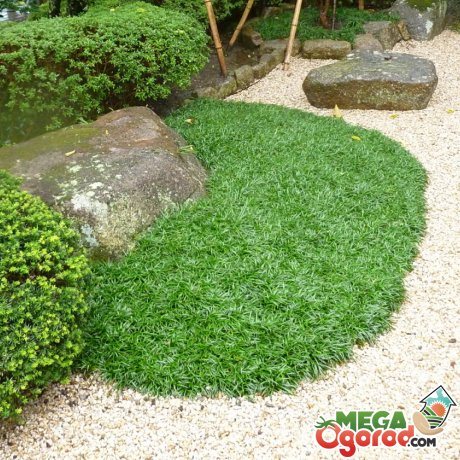

Ophiopogon is very often used in landscape gardening:
- Designers use it as a border for flower beds, which looks very beautiful and original.
- Ophiopogon is also widely used as a ground cover plant due to the fact that it grows quickly and completely covers the soil with its colorful leaves. The great advantage of this plant is that it does not have a leaf-shedding period.
Many landscape plants have an annual wilting period followed by foliage shedding, leaving a lot of debris on the beds. Ophiopogon retains the color and shine of the leaves all year round, and the death of old leaves is almost imperceptible.
When planting ophiopogon on the soil in a flower bed or flower garden, it must be borne in mind that the plant grows rapidly, and if there are short plants nearby, they can disappear under the onslaught of the Japanese lily of the valley.
It is very good to combine ophiopogon with decorative undersized trees. Growing and covering the soil, it will retain moisture for the tree longer, which will have a beneficial effect on it.
Culture and maintenance
Once planted outdoors, ophiopogon requires almost no maintenance:
- Until the plant has completely taken root, it grows slowly, weeding between the bundles is necessary.
- If the plantation is exposed to the sun, it is necessary to supply water once a week in summer in case of severe drought.
- In September or October, dry leaves are cleaned from the vegetation.


In pots:
- Water is supplied regularly throughout the growing season, and balanced fertilization during every month. In winter, watering is reduced to a minimum, but at the same time it is important to prevent the plant from drying out.
- From time to time it is necessary clean up clusters and split the plantwhen it fills the entire area of the container.
Room care
Ophiopogon is a plant that grows well in shaded areas, so it can be placed on windows on the north side of the house, in unlit corridors or in the back of the room. But for the constant appearance of flowers, the ophiopogon must be placed on the lighted side.
The ornamental bush is not pretentious to the conditions.
In a warm season, the soil should be regularly moistened. The plant can be taken out into the yard, placed on a balcony or windowsill, planted in a flower garden on the street. In the spring and summer, 3 times a month, for proper care, ophiopogon should be fed with nitrogen-containing fertilizers.
During the dormant period, which begins with the arrival of cold weather, the temperature in the room should be lowered (up to +15 degrees). If it is impossible to maintain coolness, you should regularly humidify the air. To prevent the leaves from drying out, the plant should be placed away from batteries and heaters. Watering must be reduced, but make sure that the soil does not dry out. For feeding an ornamental bush during a dormant period, phosphorus fertilizers are suitable.


Japanese lily of the valley
To transplant ophiopogon is allowed in the spring with the beginning of the active period.
Japanese lily of the valley is resistant to various diseases and pests, therefore it does not require special treatment with chemicals.
Diseases, pests and parasites
In the open field, Ophiopogon has no enemies except slugs, which can attack young leaves.
In a pot, the leaves turn yellow when the plant is too watered. Always let the mix surface dry between each watering in the summer. Little water is supplied in winter. Variegated forms lose their color if they lack light. The winter sun is not dangerous for them.
In a warm and dry atmosphere, red spiders form gray canvases under the leaves. In the event of a spider attack, the plant must be washed regularly as a preventive measure.
The leaves of the black varieties of Ophiopogon take on a bronze color, then gray, this happens in case of frost or excess water.
Medicinal properties
But this all concerned Ophiopogon in its decorative incarnation. Interestingly, it is a well-known traditional Chinese medicine. The raw material is thickened roots of Japanese ophiopogon. The ophiopogon root (in Chinese Mai Men Dong) is dug up, washed, repeatedly turning, dried in the sun and dried in the shade until 70-80% of the moisture contained in them is lost, the adventitious roots are cut off and dried.
Chinese medicine classifies them as plants used in winter when there is a lack of Yin energy. But, when used for coughing, it is not recommended only for dry cough with difficult expectoration and hemoptysis. In case of dysfunction of the gastrointestinal tract, the indication is dry mouth, constant thirst, dry irritation of the gastrointestinal tract. According to Chinese doctors, it brightens the heart and relieves irritability. But Chinese medicine is symptom-based, and scientific medicine craves classical research. And they have been actively pursued in recent years.
Active research of chemical components and their pharmacological activity, primarily in China and Japan, is ongoing. In vitro, the cytostatic activity of steroidal saponins (ophiopogonins) against liver cancer cells and some other types of cancer was noted. Isoflavonoids isolated from ophiopogon roots and named ophiopogonanones E and H have anti-inflammatory effects.
In addition, a fraction of heteropolysaccharides was isolated, which exhibited high immunoregulatory and antioxidant activity. It is explained by the presence and correlates with the amount of hexauronic acid and sulfur atoms in the molecule - the more there are, the more actively hydroxyl radicals bind. These five polysaccharides significantly increase macrophage activity, promoting phagocytic activity.
So, using this plant in phytodesign, do not be surprised if, after a few years, you find preparations from it in the pharmacy.
Photo: Elena Malankina, Rita Brilliantova
Decorative leaves and cute flowers of Japanese ophiopogon, combined with the unpretentiousness of this plant, make it a welcome guest of houses and.
In literature, the name of this flower is often translated as "Japanese lily of the valley". This comparison was due to the similarity of flowers. Just like the lily of the valley, they are located on a thin peduncle that appears in the center of the plant among the flat ones. The brushes consist of several dozen small flowers. Each elongated tube has a miniature lily.
The leaves of Japanese ophiopogon are flat, no more than five centimeters wide, pointed at the end.
Initially, in their homeland in Japan, they were dark green in color. But now varieties with heterogeneous leaf color have been bred:
- A narrow white stripe along the entire sheet cuts it lengthwise.
- A wide strip of white or cream color occupies almost the entire leaf, and only along the edge is it green.
This guest from Japan is similar to an ordinary lily of the valley in the way of breeding. Its roots also grow over great distances.
In natural natural conditions of growth, this plant is.
Ophiopogon can be grown outdoors as a perennial only in areas with mild winters. He does not tolerate frost.
In areas with more severe winters, the plant can be grown as an annual, but in this case it does not grow in large clumps.
Most often in such cases it is grown as.
Regardless of the climate and place of residence, the Japanese ophiopogon will liven up a corner of the house or garden. You just need to find the appropriate place for it.
Reproduction of Ophiopogon
Ophiopogon propagates by sowing or dividing.
Only botanical species will be propagated by sowing, variegated or black varieties must be propagated by sowing. On the other hand, seedlings grown from seedlings grow slowly, taking at least 3 or 4 years to grow before the plant reaches its adult size.
- Seed propagation
The seeds are sown in a pot or container and placed in an unheated room with a positive temperature.


Sowing can also be done outdoors in soft areas.
- Division
Spring is the best season for splitting bunches:
- Tear off bulky bundles and cut them out with a sharp tool.
- Cut the rhizomes into segments with 8-10 leaves for as many roots as possible.
- Plant immediately in the soil of ripe compost.
- Place each bunch in a cup or pot 8 cm in size and treat it immediately as an adult shrub.
Ophiopogon: description and photo
Rhizome branched, shallow, with tuberous formations. Forms a basal rosette of sessile narrow-lanceolate leaves 20–35 cm long and 1 cm wide. The leaf blade is narrow, pointed upwards. The color is green, with golden and silver lines and a purple tint. Dense growth persists throughout the year.
Ophiopogon is suitable for landscaping household plots
The blooming period is from July to September. Dense peduncles 20–25 cm long, burgundy. In the apical part, spike-shaped inflorescences appear, of a purple color. In autumn, the plant is covered with blue-resinous clusters of large peas with yellow seeds inside.
There are 20 species in the genus, only 3 are cultivated:
- "Japanese" - with a fibrous tuberous root system. Long linear leaves stretch up to 30 cm. The plate is bent along the central axis. Loose inflorescence 5–8 cm long, on a short peduncle, red-violet hue.
- "Yaburan" is a rhizome perennial with dense bushes 25–80 cm high. Leathery, linear leaves with longitudinal venation along the lower surface. Erect peduncle with tubular brushes 15-18 cm white or blue.
- "Flat-shot" - forms a spreading curtain. Narrow multiple foliage of a rich lettuce color scheme 16-30 cm long. In summer, sprinkled with white-pink inflorescences, later - with dark berries.
In landscape design, the Nigrescens variety is valued for its high frost resistance: it can withstand temperatures as low as -25 ° C.
The use of ophiopogon for healing the body
Lily of the valley exhibits antimicrobial activity - it has phytoncidal properties. These substances enhance the regenerative processes in tissues, stimulate the body's defenses and immune forces. That is why decorating household plots with this plant near the house is not only beautiful, but also useful.The air enriched with phytoncides improves the health of people suffering from diseases of the nervous and respiratory systems. Therefore, walks before bedtime in gardens and squares where ophiopogon grows are useful.
Its medicinal properties are especially well known and used in China. The roots of this plant are used: for a wet cough, diseases of the gastrointestinal tract, cardiovascular and nervous systems. Fatty acids, isoflavonoids, polysaccharides, cyclic peptides, saponins are found in the root system of monkey grass. Extensive research is being conducted on the use of steroidal saponins for the treatment of patients with liver cancer and other cancers. Isoflavonoids have an anti-inflammatory effect and are used to treat patients with acute skin inflammation.
Growing lily of the valley as a home or garden plant, you can not only admire it, but also be healthy.
Botanical description
The ophiopogon root is located shallow from the surface of the earth. On a branched rhizome there are small nodules. Above the ground, a dense growth of many basal rosettes is formed. The linear leaves have smooth sides and a pointed edge. The color of glossy leaf plates can range from light green to gray-violet. The length of the leaves is 15-35 cm, and the width does not exceed 1 cm.
Ophiopogon in the photo is a dense growth. It preserves it throughout the year and does not shed its leaves. Flowering occurs in July-September. Straight, dense peduncles about 20 cm long grow from the base of the turf.Their surface is painted in burgundy color. The top of the stem is crowned with a spike-shaped inflorescence. Small flowers have a short tube of six petals fused at the base. The buds are purple.
At the end of flowering, the ophiopogon herb is covered with bunches of blue-black round berries. Inside the berry are yellowish round seeds.
Varieties
There are 20 species in the genus ofiopogon, of which only three are used in culture. Also, breeders have bred several hybrid varieties of ophiopogon.
The plant is a rhizome herbaceous perennial, which forms dense clumps 30-80 cm high. Leaf rosettes consist of many linear, leathery leaves. The edge of the sheet plate is blunt. Its outer surface is colored dark green, and relief longitudinal veins are visible from below. The length of the leaves can reach 80 cm, and the width is 1 cm. On an erect peduncle, an inflorescence 15 cm long opens. Many tubular white or light lilac flowers in the shape of a lily of the valley exude a delicate, pleasant aroma. Varieties of ophiopogon yaburan:
- variegata - along the edges of the leaf plate has contrasting white stripes;
- aureivariegatum - lateral stripes on the leaves are painted golden;
- nanus is a compact variety that can withstand frosts down to -15 ° C;
- white dragon - the leaves are almost completely white with a narrow green stripe in the middle.
The plant has a fibrous rhizome covered with tubers. The length of the rigid linear leaves is 15-35 cm, and the width is only 2-3 mm. Leaflets are slightly curved towards the central vein. On a short peduncle there is a loose inflorescence 5-7 cm long. Small, drooping flowers are painted in lilac-red color. The petals grow together into a tube 6-8 mm long. Popular varieties:
- compactus - forms low, narrow curtains;
- Kyoto Dwarf - curtain height does not exceed 10 cm;
- Silver Dragon - there is a white stripe in the center of the leaf plate.
The plant forms a low, but very spreading clump. The length of the belt-like dark green leaves is 10-35 cm. The leaf plates of this species are wider and darker. Some varieties are distinguished by almost black vegetation. In summer, the bush is abundantly covered with large white or pink flowers, and later with many dark berries.
The flat-fired ophiopogon variety "Nigrescens" is very popular. It forms sprawling clumps up to 25 cm high with almost black foliage. In summer, the arrows of the inflorescences are covered with creamy white flowers, and in autumn the bush is completely covered with black round berries. Frost-resistant variety, can withstand cold snaps down to -28 ° C.
Indoor ophiopogon.
Compact, thermophilic species for indoor cultivation. The belt-like, twisted foliage is colored dark green. There are also variegated varieties.
General information
The evergreen ophiopogon is decorated with narrow, linear leaves that gather in bunches at the base of the stem. At the end of summer and autumn, the plant blooms with spike-shaped inflorescences with a white or purple color, they are located on straight rather long arrows and have a very decorative appearance. And the dark blue berries that form after flowering attract the eye with their contrast and unnaturalness.
Ophiopogon is an unpretentious plant, and it is not difficult to care for it at home: it is easily grown in darkened places, since it is not picky about lighting, and in nature it is usually found in the shade of trees.
There are about 20 species of wild origin, but in indoor cultivation, only two types are the most common: Japanese ophiopogon and yaburan ophiopogon, which have become the main ones in the development of many decorative hybrids.
How to choose a seat
The first step is to decide on the new place of residence of the flower, since the ophiopogon has its own requirements:
- You need warmth, for which direct sunlight or heat-emitting household appliances are suitable.
- It is important to regularly ventilate the room, but without drafts.
- The temperature should not be lower than 16 ° C.
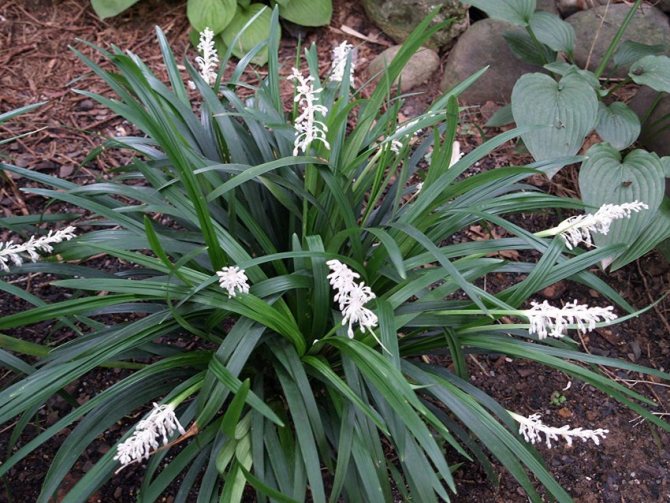

Unlike other similar plants, ophiopogon is distinguished by its unpretentiousness, which allows you to place the pot almost anywhere.
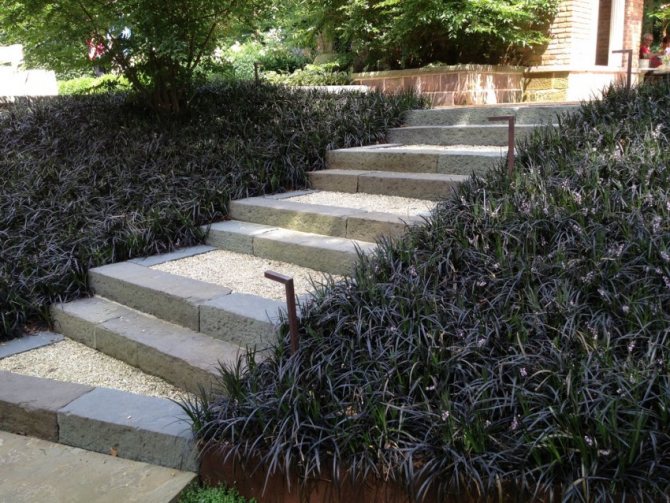

How to plant a flower
You can plant a new plant by seeds or by a shoot. In the first case, it is necessary:
- Pick up ripe seeds or buy them from a specialist store.
- Gently remove the seeds, removing the protective peel and pulp.
- Soak for 24 hours, then remove from water, spread on a clean, dry surface, leave for several hours.
- Plant in soil, cover with foil.
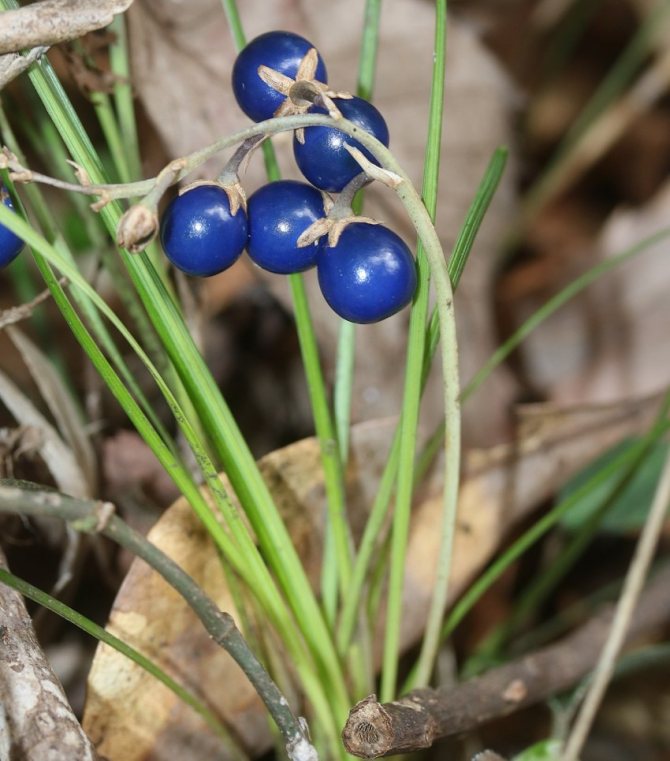

It will take at least three months to wait for new shoots from seeds, so it is faster to use the vegetative method and simply separate part of the plant so that each bush has at least three sockets.
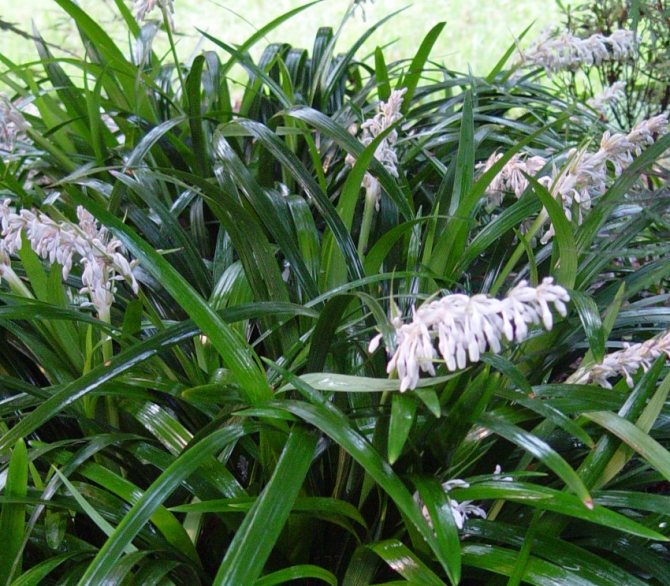

Growing ofiopogon in the garden
In open ground, ophiopogon rosettes are planted in partial shade at a distance of at least 15-20 cm between neighboring plants. Perennial normally adapts to different climatic conditions, but variegated varieties lose their variegated color in the shade.
The plant responds favorably to constant moderate moisture. Every spring, ophiopogon clumps are fertilized with organic matter and complex mineral fertilizers.
Care consists in the timely removal of dried foliage, loosening the soil between the outlets and killing weeds.
Frost-resistant varieties that can withstand significant drops in temperature hibernate in the ground without much shelter, preserving green foliage under the snow.
Types and varieties
The genus of culture has about 20 species, but only varietal forms of several of them are used in horticulture.
Japanese ophiopogon (Ophiopogon japonicus)
.Shade-tolerant plant from warm subtropical and temperate regions of Asia. A popular green-leaved variety with snow-white flowers "Albus", as well as dwarf ground cover forms with hard dark green leaves: "Compact", "Kyoto dwarf", "Nana", reaching a height of no more than 5-10 cm, are extremely shade-tolerant and resistant to trampling. Over time, miniature plantings form a dense, thick carpet.Ideal for rock gardens and Japanese style gardens.
Variegated varieties with two-colored white-green leaves (Silver Mist) or lemon-yellow foliage. The decorativeness of the Minor ophiopogon is given by bright blue, large and shiny berries against a background of dark green foliage.
Silver mist
Ophiopogon jaburan
or the white lily of the valley native to Japan. Quite a large bush with tough, dark green ribbon-like leaves. Several varieties of Yaburan were bred by breeders: the powerful variegated Vittatus, the silvery white White Dragon and the undersized Nanus.
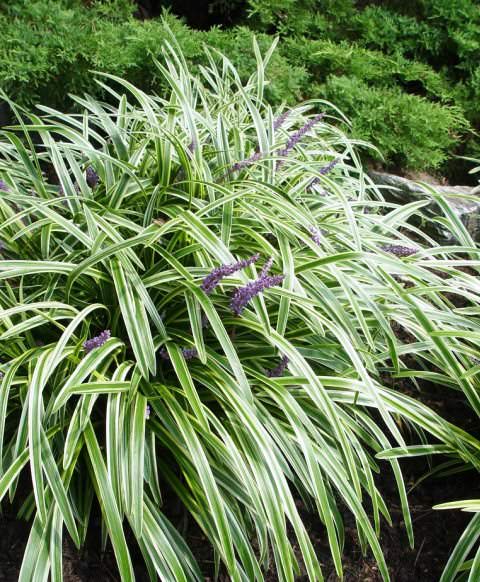

Ophiopogon planiscapus
or black grass is the most unusual and demanded type of culture in garden design. Its varietal form "Niger" or "Black Dragon" has won numerous awards, including by the British Royal Horticultural Society. A characteristic feature of the Black Dragon is its purple-burgundy, almost black leaves. The plant is fast growing and reaches a height of 20-50 cm.
In summer, straight peduncles appear between the leaves in the central part of the leaf rosette. Fragrant small flowers adorn plantations from July until the first frost. Later, purple-black shiny fruits appear. In relatively warm winters, most leaves remain evergreen.



